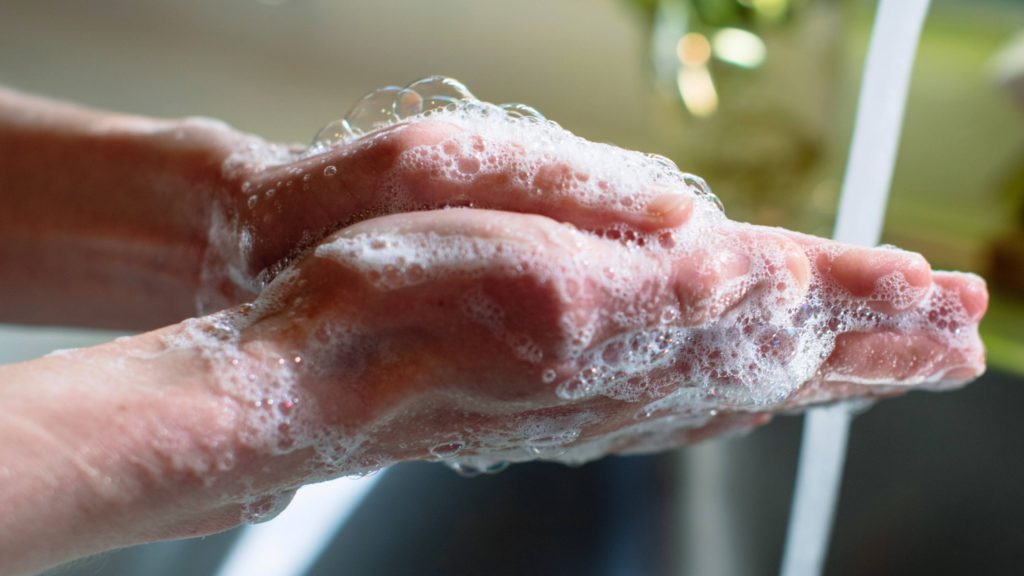
One of the best defenses against the spread of SARS-CoV-2, the virus that causes COVID-19, is hand-washing. But frequent rubbing and scrubbing can take its toll, depleting the skin of its natural moisture and oils.
So what should you do if your hands are becoming raw, dry and irritated with constant washing?
WHEN WASHING YOUR HANDS
First, it's ideal to use a soap that is hypoallergenic, free of irritants and perfumes, says Dr. Dawn Davis, a Mayo Clinic dermatologist. Also, soap in bar form tends to have fewer chemicals and more moisture content.
Next, Dr. Davis recommends washing in comfortably warm water — not scalding hot water. She also offers the familiar recommendation to sing a favorite song so that you wash your hands for at least 20 seconds.
Hand sanitizers are thought to be almost as effective as soap and water, but she says soap and water are definitely preferred, especially after using the restroom and before and after eating.
"Your skin is sort of like a kitchen sponge, and over time, with repetitive washing, it will simply dry out and look like a dry kitchen sponge," - Dr. Dawn Davis
Dr. Davis says to make sure you scrub between your fingers, including your thumbs, under your rings, the back of your hands and around your wrists. The same is true when rinsing.
"People forget about that and then soap residue stays between the digits or lies on the backs of the wrists and, over time, will get an irritant dermatitis from the soap residue that’s there," says Dr. Davis.
WHEN DRYING YOUR HANDS
Be gentle with your skin when drying your hands. Dr. Davis says it’s important to pat dry instead of rubbing or scrubbing your hands. She also says using a paper towel can be abrasive.
"I would suggest using linen, such as a cotton towel, over a paper towel," says Dr. Davis. "But using either a paper or cotton towel is preferable to letting the hands air dry. Air drying only lets the skin dry out more due to diffusion and evaporation of moisture off the skin, and then if you shake your hands dry you might contaminate surfaces if you happen to have any germs left on your skin."
"Your skin is sort of like a kitchen sponge, and over time, with repetitive washing, it will simply dry out and look like a dry kitchen sponge," says Dr. Davis.
She says after you wash and pat dry, some moisture comes back into the skin and you can trap it by putting on a moisturizer. There are multiple ways to do that, according to Dr. Davis. "You can use lotion, with creams, and/or ointments."
Watch: Dr. Davis talks about taking care of your skin with increased hand-washing.
Journalists: Sound bites with Dr. Dawn Davis are in the downloads at the end of the post. Please courtesy "Dawn Davis, M.D. / Dermatology / Mayo Clinic."
APPLYING LOTIONS, CREAMS, OINTMENTS
"Lotions tend to be the weakest of the three with regard to moisturizing because they have more water content and, so, lotion goes into the skin quite well," Dr. Davis says. "It tends to be thinner, but it will evaporate faster."
Creams are like lotion, but have less water content. They tend to be thicker, and they tend to take a longer time to absorb into the skin. They stay longer and evaporate more slowly over time.
Ointments purely sit on top of the skin. "So you can think of them like a greenhouse roof or like a lid," adds Dr. Davis. "They essentially prevent or slow the evaporation that naturally happens off the skin."
LAYERED MOISTURIZING
Apply an allergen-free or hypo-allergenic lotion or cream to the skin, and rub it in gently, making sure to get between the digits and include the wrists.
"If you don't feel that your hands are moist enough, simply wait 30 seconds to a minute, then reapply," Dr. Davis says. "You definitely get benefit from a second application. If you think your skin needs more help, you could apply a cream or a lotion first. Then use an ointment on your second application to seal it in like a roof, allowing sort of that greenhouse effect."
Dr. Davis says there are patients with sensitive skin who are having dermatitis flares. And there are also those who didn't know they had sensitive skin, until they started the extra hand-washing regimen. "So, there's sort of a three-step process in my mind of how to go above and beyond the general moisturizing," she says.
The first step would be put a single or double layer of lotion or cream on your hands, ideally before bed.
Cover those layers with an ointment, like petroleum jelly.
Then put a cotton sock over your hands and wrists, for the night.
THE 'SKIN BURRITO'
Dr. Davis says if you've tried layered moisturizing with the cotton sock example, and that isn't helping, she would kick it up a notch. "Something that in dermatology we call a wet dressing, and, with my patients, I've nicknamed the 'medical burrito,' or the 'skin burrito.'"
- Before bed, wash your hands and pat them dry.
- Put on two layers of your thickest, most effective hypoallergenic lotion or cream not ointments. Ointments won't absorb into the skin.
- Put a teaspoon of white vinegar into a glass or small bowl of warm water, and soak two clean washcloths.
- Wring them out and wrap around your hands.
- Cover your hands with socks.
"The warm water and vinegar soak adds more moisture to that greenhouse effect," says Dr. Davis. "The vinegar helps adjust the pH, which keeps the skin clean. The heat, or the warmth, allows the pores to open up and allows the extra lotion to soak deeper into the skin more effectively."
SKIN IRRITATION FROM WEARING FACE MASKS
Since health care workers and now the public are wearing face masks, it seems skin irritations on the face might need similar treatment.

"People are getting friction and irritation across their nasal bridge, behind their ears and perhaps under their chin," says Dr. Davis. "That happens because of natural wear, but also because the masks are tight, which is well-intentioned but can strangulate the skin. So this is not only causing friction and dermatitis, but some bruising."
She says the first step for mask use and sensitive skin is after you've washed and patted your face dry, apply hypoallergenic moisturizer that's made for your face. Apply the lotion or cream twice, leaving a thick layer.
"Then do the same vinegar soak with the washcloth and lay it across your face for about 15 minutes in the areas that are irritated," says Dr. Davis. "Repeat that two to three times a day, if possible, and you'll find that this humidifying method is very helpful."
Dr. Davis also recommends using zinc oxide. "The white hypoallergenic chemical that's in unscented diaper paste," she says. "It has very nice anti-inflammatory properties and you can put a thin layer across your nasal bridge, behind your ears or under your chin — in places where the mask will rub."
She says that serves as a nice barrier to the friction without affecting or decreasing the effectiveness of the mask.
Related posts:
- Science Saturday: The new super power of hand-washing
- Mayo Clinic Minute: How to properly wash your hands
- Hand-washing: Do’s and don’ts
Information in this post was accurate at the time of its posting. Due to the fluid nature of the COVID-19 pandemic, scientific understanding along with guidelines and recommendations may have changed since the original publication date.
Check the Centers for Disease Control and Prevention website for additional updates on COVID-19. For more information and all your COVID-19 coverage, go to the Mayo Clinic News Network and mayoclinic.org.







